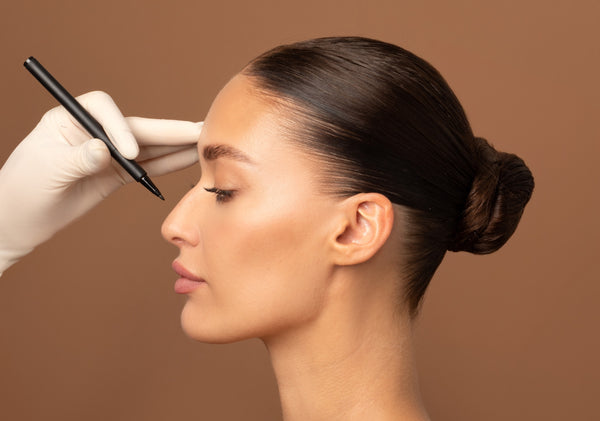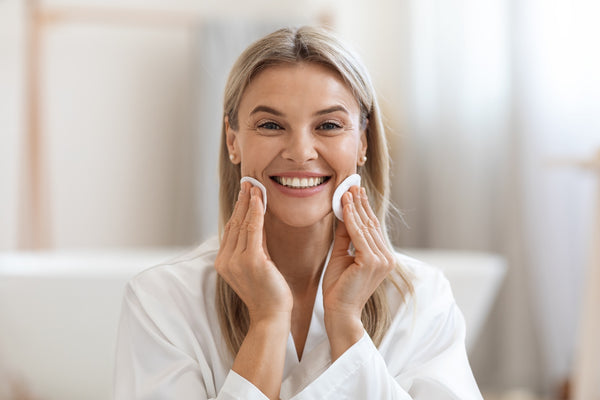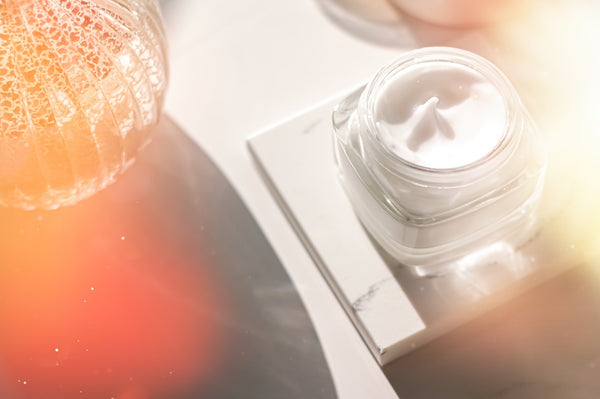Slugging 101: Should I Try Slugging With Acne-Prone Skin?

Slugging has been one of the most widely-debated and popular skincare TikTok trends to emerge this year – leaving many wondering if slugging for acne-prone skin is an appropriate way to manage their complexion.
While slugging for dry skin has resulted in a seriously radiant glow for many, the jury is still out about the overall value of slugging for those with combination or oily skin, as well as those who are currently dealing with comedones or other skin disruptions.
Below, we’re talking about what slugging is, if it’s safe to do with acne-prone skin, and the benefits you can expect from slugging.
Slugging 101: Your Guide to Slugging with Acne-Prone Skin
Ready to get your holiday-ready glow on? While it may seem controversial, slugging can be done well for those struggling with acne-prone or oily skin types…and it could result in soft, supple, and smooth skin.
Let’s get into what slugging is, and the slight modifications you can do to make slugging for acne-prone skin a personal skincare win this holiday season.
What is slugging?
Is slugging just for dry skin? Not entirely! Most skin types can benefit from incorporating slugging as a regular part of their skincare routine. This viral practice is a K-Beauty trend that emerged from South Korea – encouraging skincare enthusiasts to slather a thick layer of petroleum jelly on their face before bed, allowing it to act as a barrier to their skin as they slept.
The morning’s end result would be a smooth, moisturized, and radiant complexion, giving you a near-flawless base for your daily skincare routine or makeup regimen.
The thought process behind this trend was that the petroleum jelly (or thick skin-friendly moisturizer) used would give your skin a deeper level of hydration, and protect your skin from environmental elements as you slept – such as dry, acrid air or other irritants.
While thousands have found major success since adding this into their daily skincare routine, we do want to note that slugging for acne-prone skin requires a few simple swaps to work without triggering an outbreak.
Let’s get into the exact steps to take to help you make slugging for dry skin a success.
Slugging for dry skin: How to slug and avoid acne outbreaks

Ready to start slugging? Here are a few simple steps to help you minimize your risk of an outbreak while slugging for acne:
1. Wash your face well before you start
Whether you’re slugging for dry skin, or you’re interested in slugging for its ability to bring out your natural glow, it’s important to wash well before you start – especially if you’re dealing with oily and combination skin. These skin types can be prone to additional outbreaks due to the surface-level oil present, increasing your potential for a blockage. Slugging without cleansing beforehand can worsen this issue, locking that oil in and clogging your pores.
We recommend washing your face well with an oil-controlled cleanser and using your regular go-to non-drying toner to minimize the oil that could be on the surface of your skin. Pay attention to your “T-zone” or other particularly oily areas of your skin, ensuring that all areas have been washed thoroughly.
Consider avoiding any sort of harsh scrubs or exfoliants as you cleanse your skin. Not only can these destroy your sensitive skin barrier, but they can also increase the overall production of oil on your skin’s surface – which would compromise your overall results and experience as you slug. The same concept applies to over-washing or double cleansing. These skincare practices could end up drying out your skin, causing additional irritation and breakouts.
2. Wait on the extra steps in your skincare routine
 Before completing the next areas of your skincare routine after your wash, consider skipping additional steps (such as retinoids, or other potentially-drying products.) You want your skin to be as soothed and “prepared” as possible before you lock in that moisture with your slugging product of choice; and retinoids or other layers of product could cause irritation, excessive dryness, and general inflammation and discomfort before you begin slugging.
Before completing the next areas of your skincare routine after your wash, consider skipping additional steps (such as retinoids, or other potentially-drying products.) You want your skin to be as soothed and “prepared” as possible before you lock in that moisture with your slugging product of choice; and retinoids or other layers of product could cause irritation, excessive dryness, and general inflammation and discomfort before you begin slugging.
This begs two questions, though: Which skincare steps should you skip before you start the slugging process? Can slugging cause breakouts? We’ll tell you – it all comes down to which products you use, and which ingredients are hiding in their formulation.
Potential “steps” and products to avoid before slugging include:
-
Chemical peels and exfoliants: While it may feel tempting to reach for that bottle of peel, doing so before slugging could open you up to irritation and clogged pores, which isn’t the look you’re going for as you moisturize and slug.
-
Salicylic acid-based products: This drying ingredient can hide conveniently in toners or “anti-oil” products, which can lead to irritation and outbreaks.
-
Alcohol, fragrance, or preservative-inclusive products: If you haven’t gone through the ingredients in your skincare products, we recommend doing so before considering slugging for acne-prone skin. Go-to products with these types of ingredients can damage and dry your skin’s natural barrier, leading to acne, inflammation, and discomfort.
3. Avoid using petroleum-based products
Now that your skin is prepared and ready for slugging, we want to highlight the next adjustment you need to make to help increase your chances of a radiant result when slugging for acne-prone skin – avoiding petroleum-based products and slugging with a more “friendly” alternative that has less of a chance of clogging your pores.
Alternative products still serve the same purpose when you’re slugging from dry skin – all while keeping your chance for a breakout at bay. Traditionally, slugging is done with straight petroleum jelly or straight natural oils (such as coconut) for maximum moisturization and barrier building. We do not recommend going this route, however, especially not if you’re prone to acne or excessive sebum buildup.
However, if you’re still considering slugging for dry skin, you’re in good company. Many choose to take their chances with Vaseline over their favorite go-to oily skin products or are currently on the hunt for the next best option that can still get you the same results without the risk of a breakout.
We recommend using a thick-layered blend of acne-friendly moisturizer and a few drops of your favorite low-weight hyaluronic acid, keeping your skin hydrated and minimizing the risk of irritation and drying. Plus, this combo is generally more breathable than your average petroleum jelly or coconut oil, allowing you to still protect your skin’s barrier without the occlusive, oil-producing layer of the product.
Why do people slug, anyway?
Slugging, though unconventional in both name and application method, can bring a ton of benefits and leave you with a youthful, radiant complexion. If you’re dealing with dry or combination skin in addition to frequent acne breakouts, you might consider trying it using our methods above to minimize your chance of a flare (while still enjoying the range of slugging benefits in your daily skincare routine!)
Here are just a few of the effects you can expect to see on your skin after a few slugging sessions:
-
Deeper moisturization: Your skin has natural hydration that is lost over the course of your day – which is known as transepidermal water loss. This can happen for a variety of reasons, such as environmental effects or drying, acrid air hitting your face over the course of your day. Slugging helps your skin to retain moisture as you sleep, working double-time to keep your skin Instagram-ready as you get your beauty rest. We love a good time-saving hack and do believe that slugging can be a very effective way to keep your skin hydrated. This is especially true for those dealing with dry or combination skin!
-
Better damage control: Slugging can help your barrier to heal and remain protected for an extended period of time, allowing your skin’s natural rejuvenation processes to take place.
-
Enhanced barrier protection: Slugging is a great way to put an extra layer of protection between your sensitive skin and your external environment, keeping away harmful molecules or bacteria that could be lurking in your sheets or pillows. However, it can also work the other way – locking bacteria and oils into your skin if you don’t wash and prep properly beforehand. To minimize your risk of an outbreak, be sure to cleanse with your favorite acne-friendly cleanser, and consider a light alcohol-free toner before applying your slugging products.
Ask a Pro: Everything you need to know about the viral TikTok slugging trend
Now that you know that you can try the viral slugging skincare hack while minimizing your risk of an acne flare, we’re going to answer your related questions about best practices, tricks, and general inquiries around the K-Beauty skin sensation that’s completely dominated the skincare space this year.
Can slugging help acne?
If done correctly, slugging does have the potential to help resolve your recurring acne problems – specifically if they are caused by a damaged skin barrier or chronic dehydration. However, it must be done correctly to minimize your chances of oily buildup and clogged pores. We recommend using a thick layer of your favorite skin-friendly moisturizing cream,
with the optional add-in of a few drops of your favorite low-weight hyaluronic acid for an extra dose of powerful hydration. Done in this way, you could help resolve your acne or lessen your chances of a painful breakout.
However, if you do slugging the traditional way (which uses excessive amounts of regular natural oils or petroleum jelly), you could make your problem worse in the long-run or clog your pores.
Does vaseline help with acne?
While many do use vaseline in their daily skincare routine, it is not shown that vaseline actually helps with acne. In fact, it could make it worse due to its lack of breathability which could block your pores.
How often should you slug?
Slugging is a great way to moisturize your skin, especially if you’re prone to excessive dryness and barrier damage. However, you shouldn’t slug too much, even using your moisturizer and hyaluronic acid combo. Instead, we recommend reserving this skincare step for just two or three days of your week, sticking to your regular routine in between. This keeps your skin healthily moisturized without putting you at too high of a risk for both product and oil buildup.
Do you wash off the Vaseline after slugging?
Whether you use Vaseline or other skincare products to slug with, it’s important to regularly cleanse and prep your skin the morning after. Leaving thick layers of any product on your skin for a prolonged period of time can lead to irritation and breakouts, which will compromise your end results after slugging. There’s no special regimen to be followed, however. Simply sticking with your daily skincare routine and washing thoroughly should be good enough to return your skin surface to its natural state.
How do you sleep after slugging?
Slugging is great for your skin, but it can take a toll on your bedsheets! There are a few ways you can minimize the mess if you slug before you sleep:
-
Towel up: If the texture isn’t too much, sleeping with a soft towel on top of your pillow or sleeping area can help you minimize the mess after slugging as you sleep. This is especially helpful if you’re an active sleeper.
Watch your spread: Putting too much product can lead to breakouts and buildup. If you can see tracks your face makes after slugging, you’re likely putting on too much product. Instead, apply a single layer of product to your face, letting the surface absorb and dry as much as possible. Try sleeping on your back or in a position where your face won’t come into contact with any surfaces, minimizing your risk of a mess.
- Wear a wrap: Consider applying a thin face wrap to the slugged surfaces of your face, leaving ample space to breathe freely through your nose and mouth. This covers the product-covered areas and protects your skin from exterior disturbance.









